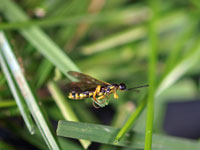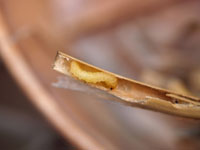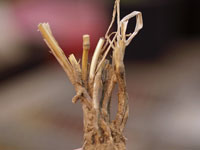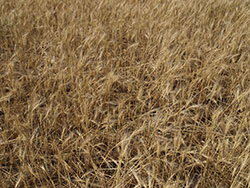by B. Irell and F. Peairs* (10/14)
Quick Facts…
- The wheat stem sawfly is a native grass-feeding insect that emerged as a significant pest of winter wheat in Colorado in 2010.
- Adults emerge in late May or early June and are generally active when winds are calm and field temperatures are above 50° F.
- Several parasitic wasps attack wheat stem sawfly but the presence and effectiveness of natural enemies in Colorado has not been determined.
Introduction
The wheat stem sawfly is a native grassfeeding insect that has long been a threat to spring wheat production in the northern plains. In the early 1980s, however, it emerged as a significant pest of winter wheat as well. Since then, sawfly infestations in winter wheat have spread from North Dakota and Montana into southeastern Wyoming, the Nebraska Panhandle, and, most recently, northeastern Colorado. Damage to winter wheat was first reported in Colorado in 2010, from areas along Colorado Highway 14 in Weld County. Since that time, it has been found infesting winter wheat as far south as Baca County.
Identification/Life Cycle
 |
| Figure 1: Adult wheat stem sawfly. |
 |
| Figure 2: Sawfly larva in stub. |
 |
| Figure 3: Stubs in which wheat stem sawfly larvae overwinter. |
The wheat stem sawfly produces one generation per year. Adults emerge in late May or early June and are generally active when winds are calm and field temperatures are above 50° F. The adult wheat stem sawfly (Figure 1) is about ¾ of an inch long with smoky-brown wings. It is wasplike in appearance, with a shiny black body with three yellow bands around the abdomen. When not in flight they often are found on wheat stems, positioned with the head pointed downward.
Females lay eggs immediately upon emergence and typically live about one week. The adult emergence and flight period continues for 3-6 weeks. They are not strong fliers and usually only fly until they find the nearest wheat field or other suitable host grasses. In wheat, this often results in more serious problems occurring at the field margins closest to the adult emergence site, which is the previous year’s wheat field. They preferentially select the largest wheat stems available and insert eggs into the first available internode or when a stem is fully developed, below the uppermost node. If sawflies are abundant, eggs may be laid in smaller stems, and multiple eggs may be laid in a single stem. However, only one larva will survive in each stem due to cannibalism. Females lay an average of 30-50 eggs, depending on the size of available host stems. Eggs are difficult to detect because they occur inside the stem.
Sawfly larvae are always found within the stem and will assume an S-shaped position when taken out of the stem. They move slowly down the stem as they feed, for approximately 30 days. Sawfly larvae (Figure 2) are cream colored, have a broad head, and are ½ to ¾ of an inch in length when fully grown. When they are mature they move down towards soil level and cut a V-shaped notch around the interior of the stem. They then seal the interior of the stem just below the notch with frass and move down near the crown. The upper stem often breaks at this weakened notch just prior to harvest, and the remaining stem containing the overwintering chamber is referred to as the ‘stub’ (Figure 3). The larvae overwinter in the stubs, slightly below soil level, before pupating in early spring. They produce a clear protective covering that protects them from excess moisture and moisture loss.
Host Plants and Damage
 |
| Figure 4: Lodging caused by wheat stem sawfly. |
The wheat stem sawfly has traditionally infested spring wheat, but over the last few decades the damage is becoming increasingly common in winter wheat. It also feeds in several hollow-stemmed non-cultivated grasses, including quackgrass, smooth brome and various wheatgrasses. It does not attack corn or broad leaf crops. Although the sawfly may lay eggs in other cereals, including barley, oat, and rye, larvae rarely mature in barley and rye and do not survive in oat.
Darkened areas on the stem, just beneath the node, indicate larval infestation. To verify the presence of the sawfly in a suspected plant, split the stem from top to bottom. A stem filled with a sawdust-like substance indicates feeding activity. The larva will most likely be located in a chamber within the stem, just above the crown.
The most visible wheat stem sawfly damage is stem breakage or lodging just prior to harvest (Figure 4). The stem is greatly weakened by the groove the larva cuts around the base of the plant. Lodging becomes more obvious as harvest approaches and results in yield loss of five to ten percent due to unrecoverable wheat heads because the combine cannot pick up the lodged stems. In addition, physiological damage caused by feeding activity results in yield losses of ten to twenty percent in infested heads that are harvested.
Management
Cultural Controls:
Tillage reduces wheat stem sawfly survival, however, its impact on overall sawfly abundance and on damage to the next wheat crop is variable. Shallow tillage after harvest lifts the crowns and loosens the soil around them. This maximizes the larvae’s exposure to the late summer dryness and winter cold, increasing mortality. Intense tillage that buries stubble also reduces sawfly survival, but to a lesser degree. Intense tillage may interfere with important biological control agents and will increase the risk of soil erosion. No-till has been linked to many of the recent wheat stem sawfly problems in the region. However, the advantages of controlling the sawfly with tillage must be weighed against the considerable benefits of no-till.
Planting attractive varieties of trap crops such as barley, oat or rye along the edge of wheat fields may be effective in decreasing damage and reducing the number of sawflies the following year. The sawflies will oviposit in the trap crop, but the larvae will be unable to complete development. This method is especially effective when sawfly abundance is low to moderate and significant infestations are limited to the field margins. However, when sawflies are abundant, females may move past the trap crop and into the wheat to oviposit, resulting in significant damage.
Planting wheat in larger blocks as opposed to narrow strips is another cultural practice that may reduce sawfly damage potential. This minimizes the amount of field border adjacent to stubble where sawfly adults will be emerging, and thus, the part of the field most vulnerable to infestation. Sawflies are not strong fliers and tend to fly only until they reach a stem that is suitable for egg-laying, which is the basis for this practice. Though the soil erosion benefits of planting in narrow strips may be reduced, larger fields are still a viable option if erosion is addressed by no-till practices. Use crop diversification to minimize the amount of wheat in the cropping system. Also, arrange rotations to avoid planting wheat in fields adjacent to fields that contained wheat in the previous year.
Resistant Wheat Varieties:
Solid stem varieties of wheat have been shown to be effective in reducing damage caused by the wheat stem sawfly. The availability of several adapted solid-stemmed wheat cultivars provides a viable management option for parts of the northern High Plains. In areas where the sawfly is a recent arrival, wheat breeding programs are beginning to focus on incorporation of the solid stem characteristic into adapted varieties, using both conventional selection and linked DNA markers. The program at Colorado State University also is initiating long term research into novel methods for making the wheat plant less attractive to the sawfly.
Biological Control:
Several parasitic wasps attack wheat stem sawfly on the northern plains, and these are thought to be important mortality factors. The presence and effectiveness of natural enemies in Colorado has not been determined.
Chemical Control:
Currently available insecticides are ineffective and cost-prohibitive. The most promising strategy seems to be control of adults to prevent egg-laying. However, the prolonged flight period likely would require repeated treatments and there is no evidence for the effectiveness of this approach. Using solid-stemmed cultivars and cultural controls are currently the most effective alternatives.
*B.Irell, student, department of electrical and computer engineering, Colorado State University; F. Peairs, professor and Extension entomologist, department of bioagricultural sciences and pest management, Colorado State University. 6/11. Revised 10/14.
Colorado State University, U.S. Department of Agriculture, and Colorado counties cooperating. CSU Extension programs are available to all without discrimination. No endorsement of products mentioned is intended nor is criticism implied of products not mentioned.
Go to top of this page.





